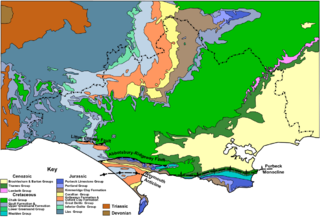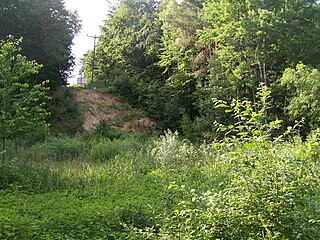
Sedimentary rocks are types of rock that are formed by the accumulation or deposition of mineral or organic particles at Earth's surface, followed by cementation. Sedimentation is the collective name for processes that cause these particles to settle in place. The particles that form a sedimentary rock are called sediment, and may be composed of geological detritus (minerals) or biological detritus. The geological detritus originated from weathering and erosion of existing rocks, or from the solidification of molten lava blobs erupted by volcanoes. The geological detritus is transported to the place of deposition by water, wind, ice or mass movement, which are called agents of denudation. Biological detritus was formed by bodies and parts of dead aquatic organisms, as well as their fecal mass, suspended in water and slowly piling up on the floor of water bodies. Sedimentation may also occur as dissolved minerals precipitate from water solution.

The Western Interior Seaway was a large inland sea that split the continent of North America into two landmasses. The ancient sea, which existed from the early Late Cretaceous to the earliest Paleocene, connected the Gulf of Mexico, through the United States and Canada, to the Arctic Ocean. The two land masses it created were Laramidia to the west and Appalachia to the east. At its largest extent, it was 2,500 feet (760 m) deep, 600 miles (970 km) wide and over 2,000 miles (3,200 km) long.

Dorset is a county in South West England on the English Channel coast. Covering an area of 2,653 square kilometres (1,024 sq mi); it borders Devon to the west, Somerset to the north-west, Wiltshire to the north-east, and Hampshire to the east. The great variation in its landscape owes much to the underlying geology, which includes an almost unbroken sequence of rocks from 200 to 40 million years ago (Mya) and superficial deposits from 2 Mya to the present. In general, the oldest rocks appear in the far west of the county, with the most recent (Eocene) in the far east. Jurassic rocks also underlie the Blackmore Vale and comprise much of the coastal cliff in the west and south of the county; although younger Cretaceous rocks crown some of the highpoints in the west, they are mainly to be found in the centre and east of the county.

The Karoo Supergroup is the most widespread stratigraphic unit in Africa south of the Kalahari Desert. The supergroup consists of a sequence of units, mostly of nonmarine origin, deposited between the Late Carboniferous and Early Jurassic, a period of about 120 million years.
The Coon Creek Formation is a geologic formation located in western Tennessee and extreme northeast Mississippi. It is a sedimentary sandy marl deposit, Late Cretaceous (Maastrichtian) in age, about 70 million years old. The formation is known for producing mosasaurs and plesiosaurs, particularly at Coon Creek in McNairy County, Tennessee, which the formation is named for. Additionally, the formation produces many other marine invertebrates such as Turritella and the state fossil of Tennessee, the bivalve Pterotrigonia thoracica, as well as other fossils such as crabs.

The Ecca Group is the second of the main subdivisions of the Karoo Supergroup of geological strata in southern Africa. It mainly follows conformably after the Dwyka Group in some sections, but in some localities overlying unconformably over much older basement rocks. It underlies the Beaufort Group in all known outcrops and exposures. Based on stratigraphic position, lithostratigraphic correlation, palynological analyses, and other means of geological dating, the Ecca Group ranges between Early to earliest Middle Permian in age.
The geology of Illinois includes extensive deposits of marine sedimentary rocks from the Palaeozoic, as well as relatively minor contributions from the Mesozoic and Cenozoic. Ice age glaciation left a wealth of glacial topographic features throughout the state.

The Posidonia Shale geologically known as the Sachrang Formation, is an Early Jurassic geological formation of southwestern and northeast Germany, northern Switzerland, northwestern Austria, southern Luxembourg and the Netherlands, including exceptionally well-preserved complete skeletons of fossil marine fish and reptiles. The Posidonienschiefer, as German paleontologists call it, takes its name from the ubiquitous fossils of the oyster-related bivalve Posidonia bronni that characterize the mollusk faunal component of the formation.

The Straight Cliffs Formation is a stratigraphic unit in the Kaiparowits Plateau of south central Utah. It is Late Cretaceous in age and contains fluvial, paralic, and marginal marine (shoreline) siliciclastic strata. It is well exposed around the margin of the Kaiparowits Plateau in the Grand Staircase – Escalante National Monument in south central Utah. The formation is named after the Straight Cliffs, a long band of cliffs creating the topographic feature Fiftymile Mountain.

The Champlain Sea was a prehistoric inlet of the Atlantic Ocean into the North American continent, created by the retreating ice sheets during the closure of the last glacial period. The inlet once included lands in what are now the Canadian provinces of Quebec and Ontario, as well as parts of the American states of New York and Vermont. Today, the remains of the sea include the St. Lawrence Seaway, Lake Champlain, Lake of Two Mountains on the lower Ottawa River, the lower Saguenay River, as well as other lakes, islands and shores.

The Oulad Abdoun Basin is a phosphate sedimentary basin located in Morocco, near the city of Khouribga. It is the largest in Morocco, comprising 44% of Morocco's phosphate reserves, and at least 26.8 billion tons of phosphate. It is also known as an important site for vertebrate fossils, with deposits ranging from the Late Cretaceous (Cenomanian-Turonian) to the Eocene epoch (Ypresian), a period of about 25 million years.

The Pisco Formation is a geologic formation located in Peru, on the southern coastal desert of Ica and Arequipa. The approximately 640 metres (2,100 ft) thick formation was deposited in the Pisco Basin, spanning an age from the Middle Miocene up to the Early Pleistocene, roughly from 15 to 2 Ma. The tuffaceous sandstones, diatomaceous siltstones, conglomerates and dolomites were deposited in a lagoonal to near-shore environment, in bays similar to other Pacific South American formations as the Bahía Inglesa and Coquimbo Formations of Chile.
Nanophoca is an extinct genus of earless seals from the middle Miocene of Belgium.
Pontophoca is an extinct genus of earless seals from the middle-late Miocene of the eastern Paratethys basin and the North Sea.
Platyphoca is an extinct genus of earless seals from Neogene marine deposits in the North Sea basin.
Praepusa is an extinct genus of earless seals from Neogene marine deposits in Europe. Five species, P. boeska,P. magyaricus, P. pannonica, P. tarchankutica and P. vindoboensis, are known.

The Whitehill Formation, alternatively written as White Hill Formation and formerly known as White Band or Whitehill or White Hill Member, is a regional Early Permian geologic formation belonging to the Ecca Group in the southeastern ǁKaras Region of southeastern Namibia and Eastern, Northern and Western Cape provinces of South Africa.
The geology of Denmark includes 12 kilometers of unmetamorphosed sediments lying atop the Precambrian Fennoscandian Shield, the Norwegian-Scottish Caledonides and buried North German-Polish Caledonides. The stable Fennoscandian Shield formed from 1.45 billion years ago to 850 million years ago in the Proterozoic. The Fennoscandian Border Zone is a large fault, bounding the deep basement rock of the Danish Basin—a trough between the Border Zone and the Ringkobing-Fyn High. The Sorgenfrei-Tornquist Zone is a fault-bounded area displaying Cretaceous-Cenozoic inversion.

The Ciechocinek Formation, known in Germany as the Green Series is a Jurassic geologic formation that extends across the Baltic coast, from Grimmen, Germany, to Lithuania, with its major sequence in Poland and a few boreholes in Kaliningrad. It represents the largest largest continental area defined as deltaic in the fossil record, estimated to cover ~7.1 × 100,000 km2 (39,000 sq mi) only in the Polish realm. It is mostly known by its diverse entomofauna, composed of more than 150 species of different groups of insects, as well its marine vertebrate fossils, including remains of sharks, actinopterygians and marine reptiles, along terrestrial remains of dinosaurs, including the early thyreophoran Emausaurus and others not yet assigned to a definite genus. Its exposures are mostly derived from active clay mining of a dislocated glacial raft with exposed Upper Pliensbachian to late Toarcian shallow-marine sediments. Starting with coarse and fine sand deposits with concretions, the pure clay of the Ciechocinek Formation, after the falciferum zone, was deposited in a restricted basin south of the Fennoscandian mainland. It hosts a layer full of carbonate concretions, where a great entomofauna is recovered.

The Faluns Sea is a former sea which covered Western France from 16 to 3.5 Ma. It spreads from Normandy to Vienne by forming an inlet through what is today Brittany, Anjou, Touraine and Blésois.
















